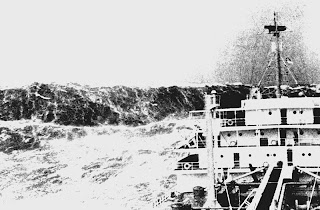What Is The Definition Of Rogue Waves
what is the definition of rogue waves
From Deadly Monster Waves On The High Seas To Modern Particle Physics
Solitons, also called solitary waves, are an intriguing topic. They are waves which behave much like particles, yet not in the sense of the quantum physical particle-wave-duality, but in a purely classical sense: They travel much like particles, meaning they do not change their shape for example, and they even bump against each other and can annihilate with their anti-solitons. On the oceans, solitons can appear as rogue waves (not bore, which is a different phenomenon), and many an ocean faring vessel has succumbed to them. They do not just lift the ship like usual waves. They smash it – again, much like one would expect from a solid particle.
 The Wilstar damaged by rogue waves, some of which are described as solitons. She still made it home. Rogue waves are a little known phenomenon, which is partially due to that they are especially historically "under reported", which is an euphemism for saying that usually nobody survived to report them. (Source: Earthsky)
The Wilstar damaged by rogue waves, some of which are described as solitons. She still made it home. Rogue waves are a little known phenomenon, which is partially due to that they are especially historically "under reported", which is an euphemism for saying that usually nobody survived to report them. (Source: Earthsky)
Information technology is not surprisingly very interested in making solitons work inside transmission channels, because they do not change their shape, and since modern particle physics is a field theory, these things pop up at the very cutting edge of fundamental physics.
I wrote an introduction to solitons [1] in 1997 and put it onto my old homepage at USC. To my surprise, this introduction became quite popular, was linked to on many forums (like The Net Advance of Physics, Altair 7 Communications, Université Paris 7 Denis-Diderot, …), and found a lot of readers over the years. Now I even got a request for giving permission to translate it to other languages like Haitian Creole. So, why not introduce it to the Science2.0 audience?
Here the introduction to the introduction; the rest can be downloaded from Science2.0 [solitons.pdf].
1.1. Historical Account
A solitary wave is defined as a spatially confined (localized), non-dispersive and non-singular solution of a non-linear field theory, i.e. one without superposition principle (possible for example in shallow water but not on a simple string). Therefore they have been thought impossible, because a dispersive and non-linear medium has been expected to alter any shape of any wave over time. Dispersion alone leads to shock fronts of the propagating wave. That the non-linearity can compensate for the dispersion leading to a propagating and stable wave having constant velocity and shape came as a surprise.
A solitary wave was firstly discussed in 1845 by J. Scott Russell [2]. He observed a solitary wave traveling along a water channel, riding along with it for miles without seeing it decay. The existence and importance was disputed until D.J. Korteweg and G. de Vries gave a complete account [3] of solutions to the non-linear hydro dynamical equation in 1895.
In 1955, research into stable and non-dispersive but localized solutions in non-linear media was taken up again when Fermi modeled the equipartition of energy between 64 weakly and non-linearly coupled harmonic oscillators numerically [4]. Starting with only one oscillator excited, the energy distributed itself over the whole system (all modes) but returned almost completely to the first excited one.
Thermodynamic equilibrium was not reached and the excitation was stable in that sense. From then onward, solitary waves or "solitons" (their definitions change from author to author) have become more and more important. Although for quite some time only classical solutions (i.e.not quantized) in low dimensional spaces have been considered, their importance was recognized in quite different areas of physics. Information technology, struggling with signal broadening along transmission lines, would certainly gain from the use of non-dispersive pulses.
For particle physicists, a localized and stable wave might be a good model for elementary particles. This provides a non-linear field theory with the possibility of what would have to be a wave packet in a linear one (newer fundamental gauge theories are non-Abelian and therefore non-linear). Notably among others is the Skyrme model that aims to describe nucleons and nucleon-nucleon interactions. Topological solitons give rise to pre-quantum mechanical quantization of charges.
For any non-linear theory, the soliton is at least as fundamental a solution as the sine wave. Recently, there have been profound advances in finding solitons in higher dimensional theories and in quantizing them. Doing quantum mechanics, one finds relations between solitons that go very deep and are entirely unexpected from a classical viewpoint.
1.2. Shallow Water Solitary Waves
A "swell" or German "Seegang" is due to the fact that the superposition principle does not apply. Bigger waves gain energy from smaller ones - they do not go through each other and reappear again undisturbed. They literally eat each other; the soliton as a "monster wave". Concentrating on waves in a straight channel with shallow water, one is effectively left with a 1+1 dimensional problem described by the Korteweg de Vries equation (non-linear hydrodynamical equation) [3]. One models the non-linearity by a factor proportional to the displacement and the dispersion by a factor proportional to its third derivative. The wave equation can be written as …
--------------------------------------------
[1] S. Vongehr: "Solitons" USC (1997)
[2] J. Scott Russell, Report of the British Association for the Advancement of Science (1845)
[3] D. J. Korteweg and G. de Vries, Phil. Mag. 39, 422 (1895)
[4] E. Fermi: "Studies of Non Linear Problems" in: Collected Papers of Enrico Fermi, E. Segre general editor, Vol. II, 978, University of Chicago Press (1965)
--------------------------------------------
More from Sascha Vongehr sorted Topic for Topic


0 コメント:
コメントを投稿